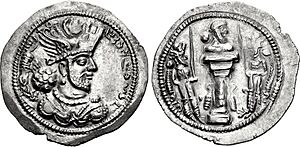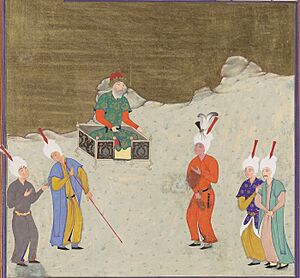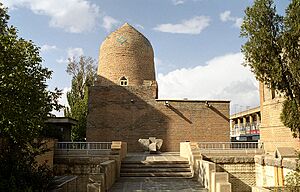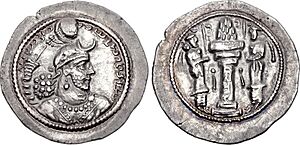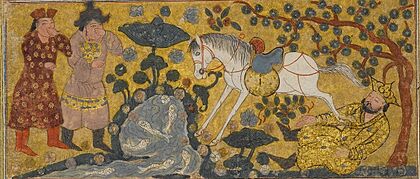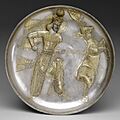Yazdegerd I facts for kids
Quick facts for kids Yazdegerd I𐭩𐭦𐭣𐭪𐭥𐭲𐭩 |
|
|---|---|
| King of Kings of Iran and non-Iran | |

5th-century plate of Yazdegerd I slaying a stag.
|
|
| Shahanshah of the Sasanian Empire | |
| Reign | 399–420 |
| Predecessor | Bahram IV |
| Successor | Shapur IV |
| Died | 420 Gurgan or Tus |
| Consort | Shushandukht |
| Issue |
|
| House | House of Sasan |
| Father | Shapur III |
| Religion | Zoroastrianism |
Yazdegerd I (also known as Yazdgerd) was a powerful ruler, called the King of Kings (or Shahanshah) of Iran. He ruled the Sasanian Empire from 399 to 420 AD. Yazdegerd was the son of Shapur III and became king after his brother, Bahram IV, was killed.
Yazdegerd I's time as king was mostly peaceful. It is seen as a time of new beginnings for the Sasanian Empire. Even though some people called him "the Sinner," Yazdegerd was a very capable ruler. He had good relationships with the Eastern Roman Empire. The Roman Emperor Arcadius even trusted Yazdegerd to look after his young son, Theodosius II. Yazdegerd I was also known for being friendly with Jews and Christians in his empire. He officially recognized the Church of the East in 410 AD. Because of this, Jews and Christians praised him, comparing him to Cyrus the Great, an ancient Iranian king who freed the Jews from captivity.
The king's peaceful and tolerant policies were not popular with the powerful nobles and Zoroastrian priests. Yazdegerd tried to limit their power, but this plan did not work out well. He was eventually killed by the nobles in a faraway part of the empire. After his death, the nobles tried to stop his sons from becoming king. His oldest son, Shapur IV, was quickly killed. Another son, Bahram V, rushed to the capital city of Ctesiphon with an army. He then forced the nobles to accept him as the new king.
Contents
What's in a Name?
The name Yazdegerd means "God-made." It comes from two old Iranian words: yazad (divine being) and -karta (made). It is similar to the Greek name Theoktistos. This name was known in many languages. For example, in Syriac, it was Yazdegerd or Izdegerd. In Arabic, it was Yazdeijerd.
Becoming King
Yazdegerd I was the son of Shapur III. He became king in 399 AD after his brother, Bahram IV, was killed. When Yazdegerd took the throne, the Sasanian Empire had been going through a tough time. The three kings before him – Bahram IV, Shapur III, and Ardashir II – had all been murdered by the powerful nobles.
Most of these high-ranking nobles belonged to strong Parthian families. They had a lot of power and acted almost like independent rulers. The Sasanian kings had little control over them. Any attempts to limit their power usually ended badly for the king. Later in Yazdegerd's rule, the powerful Parthian House of Suren became very close to the king. They played a big role in how the empire was run. Their influence grew until the end of the reign of Yazdegerd's grandson, Yazdegerd II.
Friends with the Romans

During Yazdegerd I's rule, his neighbors to the west, the Eastern Roman Empire, were having problems. There were raids, rebellions, and civil wars. Instead of attacking the weakened Roman Empire, Yazdegerd I did something surprising. He sent Roman Christian prisoners, who had been captured after a battle with the Huns, back to Roman territory.
The Roman Emperor Arcadius was so impressed by Yazdegerd's kindness that he asked him for help. Arcadius wanted Yazdegerd to protect his young son, Theodosius, and make sure he became the next emperor. Yazdegerd I agreed to be Theodosius's protector. He even threatened to go to war against anyone who tried to harm the young prince. Yazdegerd sent a wise advisor named Antiochus to help educate Theodosius. This shows how much trust there was between the two empires at that time.
Relations with Christians
A New Era for Christians
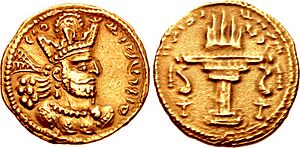
Yazdegerd I, like all Sasanian rulers, followed the Zoroastrian religion. Before him, some Sasanian kings were thought to have treated Christians very harshly. However, modern historians believe that these "persecutions" were often exaggerated. Kings usually only punished Christian leaders who refused to cooperate with the government.
Yazdegerd I's rule was a very important time for Christians in Iran. With advice from a Roman bishop named Marutha, Yazdegerd officially recognized the Church of the East in 410 AD. This was a huge step, like the Edict of Milan in the Roman Empire, which gave Christians freedom. Soon, churches, shrines, and monasteries were built. Yazdegerd even helped pay for some of these churches. He also allowed Christians to bury their dead, which was a big deal because Zoroastrians believed this would make the land unclean.
More and more Christians started working in the government. Yazdegerd even used Christian leaders as diplomats. For example, he sent the leader of the Church of the East to be his ambassador to Emperor Theodosius. Yazdegerd was mostly interested in making his empire stronger, both politically and economically. Because he was so tolerant of Christians, they described him in their writings as a "noble soul" and a second Cyrus the Great.
A Brief Change in Policy
Towards the end of Yazdegerd's reign, his patience with Christians was tested. Around 419–420 AD, a Christian bishop named Abda and some other Christians destroyed a Zoroastrian fire temple. This was a very important religious building for Zoroastrians. The king called them to explain their actions.
Yazdegerd asked Abda why he allowed his followers to disrespect the kingdom and destroy their holy places. Abda hesitated, but another priest boldly replied that he destroyed the temple because it was not a house of God. Abda refused to rebuild the temple, so he and his group were executed. In another place, a priest put out a sacred fire and held a Christian service there.
Because of these actions, Yazdegerd I was forced to give in to pressure from the Zoroastrian priests. He changed his policy and ordered Christians to be persecuted for a short time. This brief period of persecution did not change how Christians generally viewed Yazdegerd. Some of their writings even tried to explain why he had to act that way.
Relations with Jews
The Jews in Iran were treated very well by Yazdegerd I. Their religious leader even called him the new Cyrus the Great, just like the Christians did. Cyrus was the king who freed the Jews from captivity long ago. It is said that Yazdegerd greeted Jewish rabbis kindly and even quoted their holy scriptures.
Yazdegerd had a Jewish wife named Shushandukht. She was the daughter of a Jewish leader. At her request, Yazdegerd reportedly allowed Jews to settle in the city of Spahan. Shushandukht was also the mother of his son, Bahram V, who would later become king. Some historians believe that the Tomb of Esther and Mordechai in Hamadan might actually be the burial place of Shushandukht.
King's Character and Challenges
Roman sources describe Yazdegerd I as a smart, kind, and friendly ruler. They said he was well-read and known for his "noble character." He was also seen as a champion for "the poor and the wretched." However, Persian and Arabic sources often called him a "sinner" or "outcast." They said he misused his power by scaring and controlling the nobles and Zoroastrian priests.
This negative view of Yazdegerd came from his peaceful approach to the Romans and his tolerance of non-Zoroastrians, like Christians and Jews. The priests disliked him because he executed some Zoroastrian priests who disagreed with his friendly policies towards other religions. Yazdegerd knew that his previous kings had been murdered by the nobles. So, he tried to stop the nobles from gaining too much power. This put him at odds with both the nobility and the clergy. Despite these challenges, Yazdegerd was more capable than the kings before him. His reign is remembered as a time of renewal for the Sasanian Empire.
Coins and Royal Ideas
Yazdegerd I's coins show him wearing a special crown. It was a mix of the dome-shaped crown used by Ardashir II and had two castle-like shapes (merlons) and a crescent moon on top. His reign marked a change in the Sasanian Empire's focus. The empire, which used to look mostly to the West, started to focus more on the East. This change might have been because of hostile tribes in eastern Iran.
On Yazdegerd's coins, he added the title Ramshahr, which means "peacekeeper in [his] dominion." This was added to the traditional title, "King of Kings of the Iranians and non-Iranians." This new title showed a connection to ancient Iranian legends and heroes. It suggested that Yazdegerd saw himself as a protector of peace and order, much like the legendary Kayanian rulers.
During his rule, new mints (places where coins are made) were set up in cities like Yazd and Gurrah. This shows that these cities were becoming more important.
Building Projects
Yazdegerd I is known for ordering the rebuilding and improvement of several cities. These included Qumis, Hamadan, Susa, Shushtar, and Spahan. His military leaders are also said to have founded new cities like Aqda and Maybud.
Death and What Happened Next
Yazdegerd I died in 420 AD. Some historians say he died from a disease. However, a famous legend, told by the poet Ferdowsi in his epic poem Shahnameh, says something different. According to the legend, Yazdegerd was kicked to death by a mysterious white horse. The horse suddenly appeared from a spring near the city of Tus and then vanished.
Historians believe this legend was probably made up by the powerful Parthian nobles. They likely had Yazdegerd I killed in the distant northeast, which was their traditional homeland. The nobles and priests, who disliked Yazdegerd, then tried to stop his sons from becoming king.
Yazdegerd had three known sons: Shapur, Bahram, and Narseh. Shapur, who was the governor of Armenia, quickly came to Ctesiphon and became King Shapur IV. But he was soon betrayed and killed by his own courtiers. The nobles then put Khosrow, the son of Bahram IV, on the throne. However, Yazdegerd's other son, Bahram, who had grown up in the Lakhmid court, arrived in Ctesiphon with an Arab army. He then forced the nobles to accept him as the new king, Bahram V. His brother, Narseh, was made governor of Abarshahr.
Images for kids
-
5th-century plate of Yazdegerd I slaying a stag.
-
Drachma of Bahram IV
-
Solidus of Arcadius
-
Gold dinar of Shapur II
-
Drachma of Yazdegerd I
|
Yazdegerd I
Died: 420 |
||
| Preceded by Bahram IV |
King of Kings of Iran and non-Iran 399–420 |
Succeeded by Shapur IV |


